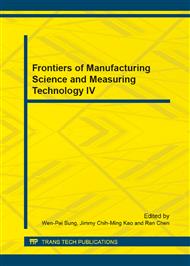[1]
S. S. Keerthi, V. Sindhwani, and O. Chapelle. An efficient method for gradient-based adaptation of hyperparameters in svm models. In B. Scholkopf, J. Platt, and T. Homan, editors, Advances in Neural Information Processing Systems 19, pages 673{680. MIT Press, Cambridge, MA, (2007).
DOI: 10.7551/mitpress/7503.003.0089
Google Scholar
[2]
Chang C -C, Lin C -J. LIBSVM: a library for support vector machines, Software available at http: /www. csie. ntu. edu. tw/cjlin/libsvm, (2001).
Google Scholar
[3]
Luo X Y, Liu F L, Chen J M, and et al., Image universal steganalysis based on wavelet packet transform, in Proc. 10th International Workshop on Multimedia Signal Processing, pp.780-784, (2008).
DOI: 10.1109/mmsp.2008.4665180
Google Scholar
[4]
R. Chandramouli, M. Kharrazi, and N. Memon, Image steganography and steganalysis concepts and practice, Proc. of IWDW'03, vol. 2939, pp.35-49, Springer, (2003).
DOI: 10.1007/978-3-540-24624-4_3
Google Scholar
[5]
Pevny T, Fridrich J. Merging Markov and DCT features for multi-class JPEG steganalysis, in Electronic Imaging. International Society for Optics and Photonics. p.650503. (1), (2007).
DOI: 10.1117/12.696774
Google Scholar
[6]
Farid H, Siwei L. Detecting hidden messages using higher-order statistics and support vector machines. In: Information Hiding, 5th International Workshop, volume 2578 of Lecture Notes in Computer Science,. 340–354, (2002).
DOI: 10.1007/3-540-36415-3_22
Google Scholar
[7]
Y. Wang and P. Moulin, Optimized feature extraction for learning based image steganalysis, IEEE Trans. Inf. Forensics Secur, vol. 2, no. 1, pp . 31-45, (2007).
DOI: 10.1109/tifs.2006.890517
Google Scholar
[8]
T. Pevny, J. Fridrich: Multiclass Blind Steganalysis for JPEG Images , Proc. SPIE Electronic Imaging, Photonics West, January (2006).
Google Scholar
[9]
Shimizu, M.; Okutomi, M, Significance and attributes of subpixel estimation on area-based matching.
Google Scholar
[10]
Niels Provos and Peter Honeyman, Hide and seek: An introduction to steganography, IEEE Security and Privacy, vol. 1, no. 3, pp.32-44, (2003).
DOI: 10.1109/msecp.2003.1203220
Google Scholar


